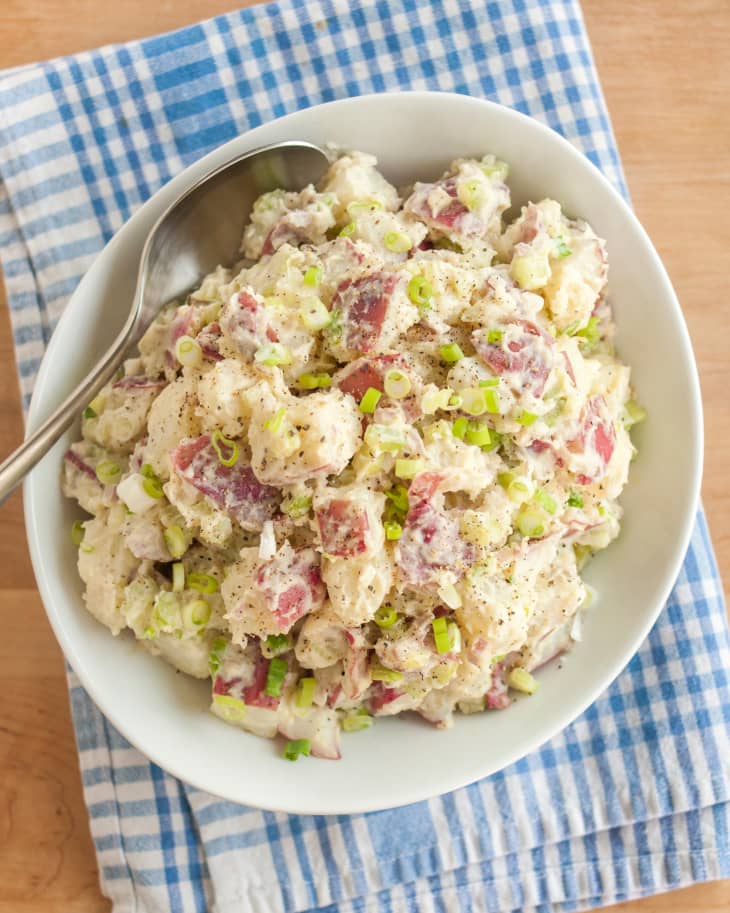5 Mistakes to Avoid When Making Potato Salad
We’re beginning to approach prime picnic and backyard barbecue season — finally! This time of year wouldn’t be complete without one of my favorite side dishes: potato salad. Chunks of well-seasoned, fork-tender potatoes tossed with some crunchy veggies and a touch of mayo or perhaps a nice vinaigrette — it’s a warm-weather staple.
No matter what your favorite potato salad style is, be sure to avoid these five common mistakes when making your next batch.
1. Using the wrong type of potatoes.
Not all potatoes are created equal when it comes to potato salad. Potatoes are divided into three general categories based on their texture — starchy, all-purpose, and waxy. For this dish, avoid using starchy potatoes, like Russets, which have a tendency to fall apart during cooking.
→ Follow this tip: Stick with waxy potatoes — like Red Bliss, New, or Fingerling potatoes — for potato salad. These varieties has the least amount of starch and does the best job at retaining its shape during boiling. All-purpose potatoes (which have a little more starch than waxy), like white and Yukon Gold, are also suitable choices for potato salad.
2. Not starting the potatoes in cold water.
When we cook veggies, we often start them in boiling water, but this shouldn’t be the case with potatoes. The biggest problem with starting potatoes in boiling water is uneven cooking. This leads the outside of the potato being overcooked and mushy, while the inside is undercooked.
→ Follow this tip: The key to perfectly cooked potatoes is starting them in a pot of cold water where they’re fully submerged. From there, bring the water to a boil, then reduce the heat to cook the potatoes at a simmer.
3. Not seasoning the water when cooking the potatoes.
A good potato salad has to be seasoned, especially if it’s being served cold. You’ll never get as much flavor if you wait to season when the potatoes are cool or when you’re dressing the salad. The key is seasoning as soon as possible.
→ Follow this tip: The key to a well-seasoned potato salad is adding salt to the water when the potatoes cook. The potatoes will absorb some of the salt, thoroughly seasoning them from the inside out, and making them more flavorful. Also, taste as you mix the salad together and season again if necessary.
4. Undercooking or overcooking the potatoes.
Potatoes are the main ingredient, so it’s essential that they’re cooked just right. Don’t let them cook long enough, and you’ll be left with firm, crunchy potatoes — not a texture potatoes should ever take on in this dish. Cook them too long, and you’ll have mushy potatoes.
→ Follow this tip: The potatoes should be cooked so they’re soft, tender, and creamy. Cook them until they are just tender when pierced with a fork. Depending on the type of potato and size of the potato cubes, this will take between eight and 12 minutes.
5. Not dressing the potatoes at the right time.
The type of dressing you plan to use, mayo-based dressing or vinaigrette, will determine when the salad should be dressed. When using vinaigrette, don’t let the potatoes cool before dressing them. And when making a mayonnaise-based potato salad, stay away from dressing warm potatoes. The hot potatoes will cause the mayonnaise to melt and become oily.
→ Follow this tip: When dressing the salad with vinaigrette, toss the potatoes with dressing while they’re still warm. They’ll absorb some of the vinaigrette and become more flavorful. When making a mayo-based salad, the opposite is true. Let the potatoes cool for at least 30 minutes to ensure the mayo doesn’t become oily when mixed into the salad.
